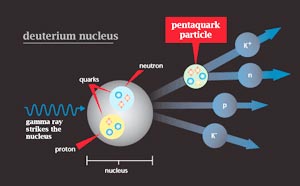This area deals with the fundamental laws and building blocks of nature and how they interact, the properties and the behavior of matter, and research into space and time and their structures.
innovations-report provides in-depth reports and articles on subjects such as astrophysics, laser technologies, nuclear, quantum, particle and solid-state physics, nanotechnologies, planetary research and findings (Mars, Venus) and developments related to the Hubble Telescope.

Two new Cassini views of Saturn’s tumbling moon Hyperion offer the best looks yet at one of the icy, irregularly-shaped moons that orbit the giant, ringed planet.
The image products released today include a movie sequence and a 3D view, and are available at http://ciclops.org, http://saturn.jpl.nasa.gov and http://www.nasa.gov/cassini.
The views were acquired between June 9 and June 11, 2005, during Cassini’s first brush with Hyperion.
Hyperion is decidedly no

Here come the X-rays, on cue. Scientists studying the Deep Impact collision using NASA’s Swift satellite report that comet Tempel 1 is getting brighter and brighter in X-ray light with each passing day.
The X-rays provide a direct measurement of how much material was kicked up in the impact. This is because the X-rays are created by the newly liberated material lifted into the comet’s thin atmosphere and illuminated by the high-energy solar wind from the Sun. The more m

Astronomers from across Europe today (July 7th) took a step closer to making their plans for a giant telescope a reality when they unveiled the scientific case for an Extremely Large Telescope (ELT) – a monster telescope with a light capturing mirror of between 50 and 100 metres, dwarfing all previous optical telescope facilities. The announcement was made at a meeting in Dwingeloo, the Netherlands and initiates the design phase of the project. Astronomers plan to use the ELT to search for p

Computers, telephones, music players keep getting smaller and more powerful, but the technology making this possible can only be shrunk so far. Leeds researchers have won £2.6m to develop the ‘disruptive technology’ of the century by exploiting nature’s ability to work on the nanoscale – heralding a revolution in the way our gadgets operate.
Semiconductor chips, containing millions of transistors, are now found in everything from cars to fridges. However, the technology behind t

Global warming could be controlled if we all became vegetarians and stopped eating meat. That’s the view of British physicist Alan Calverd, who thinks that giving up pork chops, lamb cutlets and chicken burgers would do more for the environment than burning less oil and gas.
Writing in this month’s Physics World, Calvert calculates that the animals we eat emit 21% of all the carbon dioxide that can be attributed to human activity. We could therefore slash man-made emissions of carbon d

New, higher precision data that could only have been gathered at the Department of Energy’s Thomas Jefferson National Accelerator Facility (Jefferson Lab) shows the Theta-plus pentaquark doesn’t appear in another place it was expected. This intriguing finding contradicts evidence previously presented by Jefferson Lab researchers that they had sighted a pentaquark, a particle built of five quarks. Volker Burkert, a Jefferson Lab Experimental Hall Leader, will present this preliminary result in a